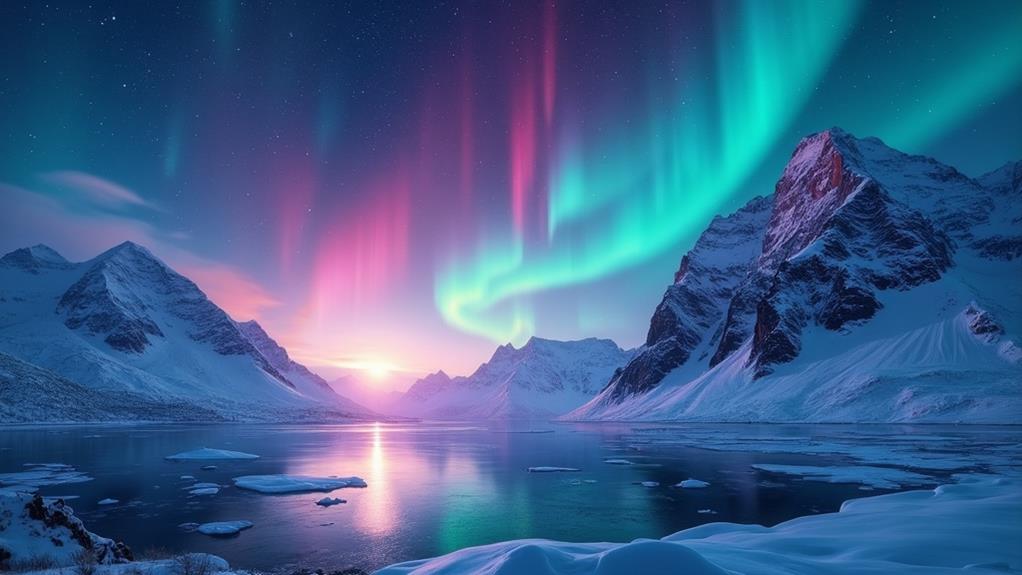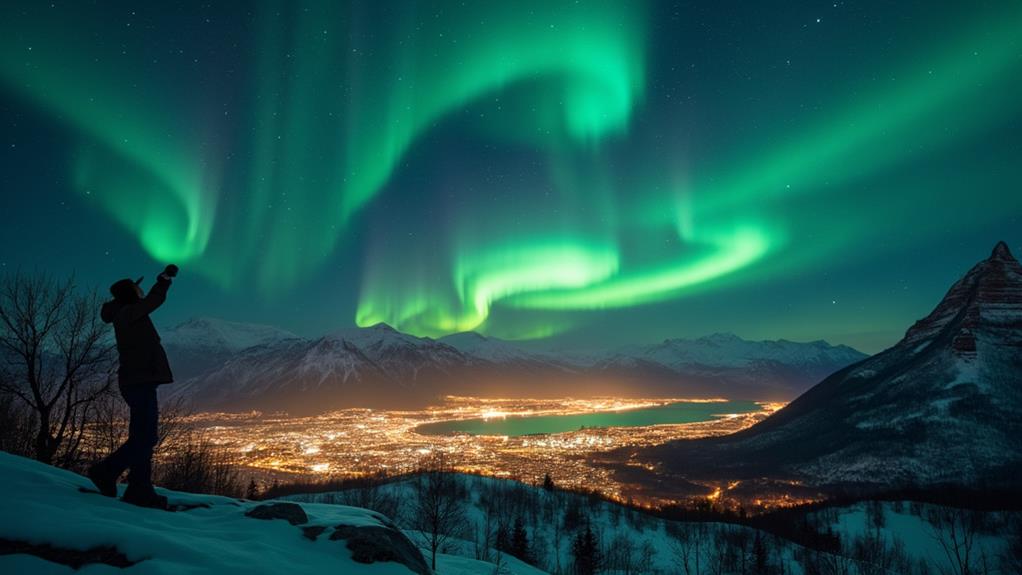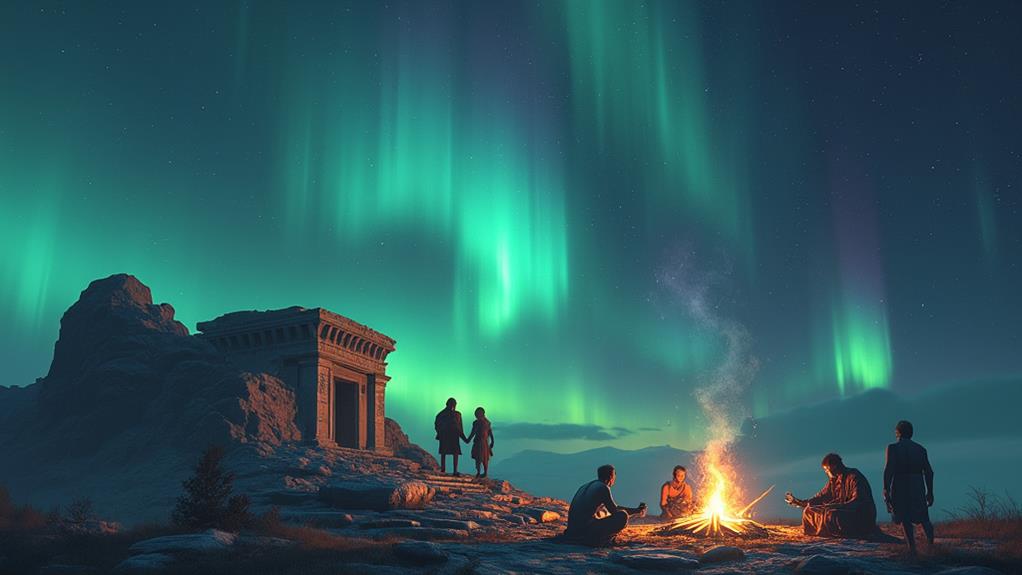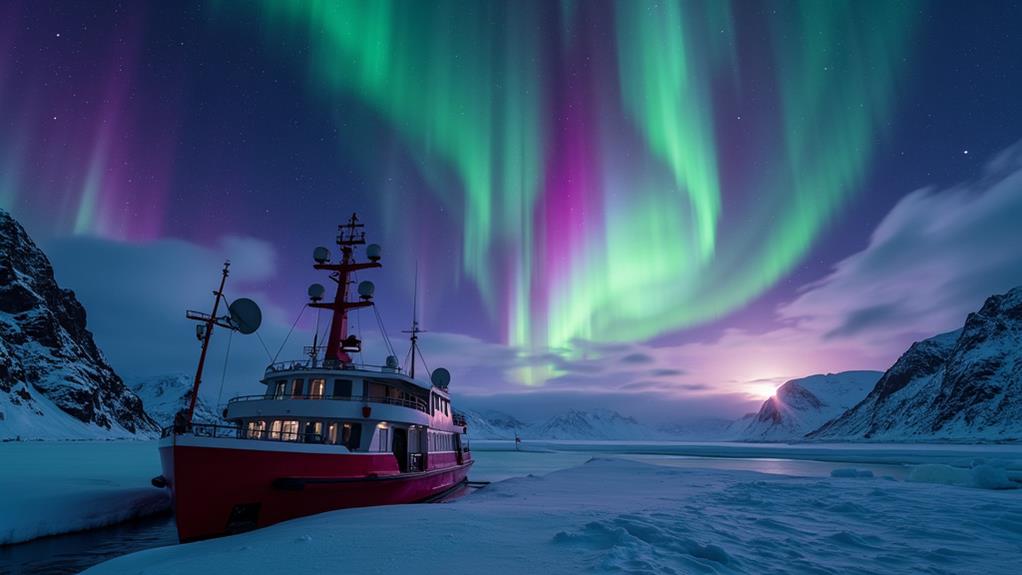The Northern Lights in Arctic Culture and Tradition
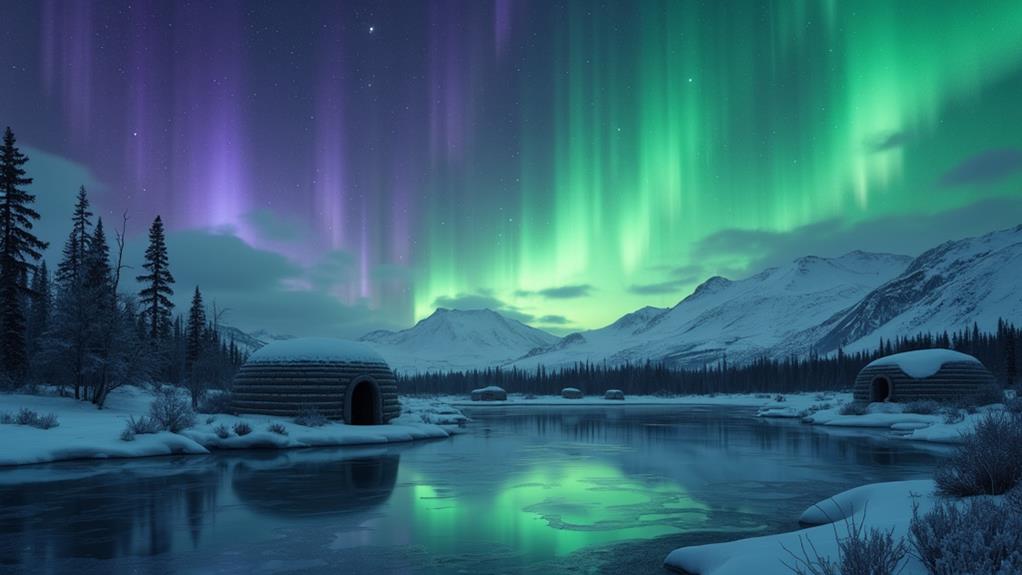
Imagine standing under the vivid dance of the Northern Lights, knowing these celestial displays are deeply woven into Arctic cultures. You're exploring more than just a natural phenomenon; you're stepping into a world where Indigenous peoples like the Sámi and Inuit view the auroras as essential messages or symbols of prosperity. Finnish folklore tells of "revontulet," fire foxes lighting up the night sky, while Greenlandic tales speak of spirit highways. Curious about how these myths shape community identity and respect for nature? There's much more to uncover about their significant impact on tradition and spirituality.
Cultural Significance
The Northern Lights, or aurora borealis, hold profound cultural significance across Arctic communities, often seen as manifestations of spirits or gods. For indigenous groups like the Sámi and Inuit, these lights are more than just a natural phenomenon; they are omens or messages from the afterlife. Their rituals and practices reflect a deep respect and caution toward this celestial display, intertwining their daily lives with the spiritual world.
In Finnish folklore, the auroras are known as "revontulet," or "fire foxes." The myth states that a mythical fox creates sparks in the sky, symbolizing a deep connection to nature. This interpretation highlights how different cultures see the Northern Lights as essential to their understanding of the world around them.
Greenlandic narratives describe the auroras as "arsarnerit," or "highway of the dead," portraying them as the spirits of the deceased dancing on their path to the afterlife. This view emphasizes themes of loss and remembrance, showing how the Northern Lights serve as a bridge between the living and their ancestors.
Many Native American tribes, such as the Cree and Algonquin, interpret the Northern Lights as reflections of their ancestors or divine connections. These lights reinforce community identity and spiritual beliefs, making the aurora borealis a crucial element in Arctic cultures.
Myths and Legends
Myths and legends about the Northern Lights, known as aksarnirq in Inuit culture, have captivated Arctic cultures for centuries. In Inuit beliefs, these lights are thought to be the souls of the dead dancing in the sky, occasionally playing with walrus skulls and guiding the living through their celestial games.
In Finnish folklore, the aurora borealis is called revontulet, meaning "fire fox." This name originates from a legend in which a mythical fox races across the tundra, creating sparks that light up the sky with its tail.
Norse mythology associates the lights with the Bifröst Bridge, a burning rainbow bridge that valiant warriors cross to reach Valhalla, symbolizing honor and valor in battle. The Algonquin tribes have their own tales, depicting the auroras as reflections of fires made by the cultural hero Nanabozho, linking the Northern Lights to themes of creation and spirituality.
Greenlandic beliefs view the auroras as a "highway of the dead," where the spirits of departed loved ones dance across the sky, emphasizing the cultural importance of loss and remembrance.
Symbolism and Spirituality
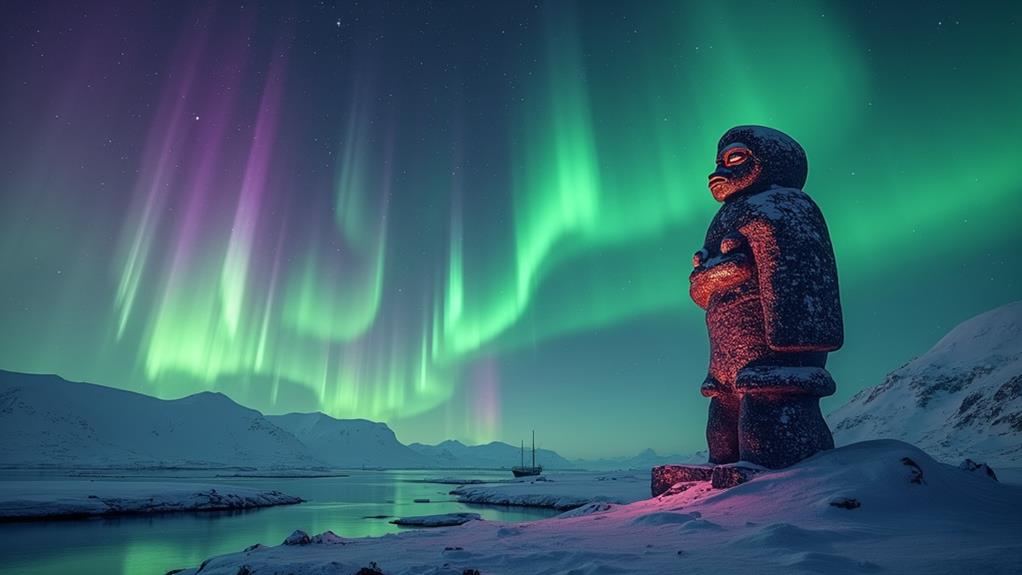
When you gaze at the Northern Lights, you're not just witnessing a stunning display of colors; you're observing symbols of hope and prosperity deeply embedded in Arctic cultures. Indigenous tribes believe these lights guide and protect them, serving as celestial beacons in the expansive, dark landscape. The auroras provide reassurance and a sense of direction, embodying both spiritual and practical significance.
Hope and Prosperity Symbols
Embracing the mystical glow of the Northern Lights, Arctic cultures find profound symbolic meaning in these natural wonders. For the Inuit, the auroras represent the souls of the departed playing, establishing a spiritual connection that fosters hope and remembrance among the living. This belief strengthens community bonds and continuity, as the spirits are seen as protectors guiding them toward prosperity.
Similarly, the Sámi people historically viewed the Northern Lights as both powerful and potentially dangerous omens. Nevertheless, they recognized the auroras as indicators of good fortune, crucial for communal survival and their deep connection to the land. The lights signaled bountiful fishing and successful hunting, ensuring the Sámi people's prosperity.
Finnish folklore refers to the auroras as "revontulet," or fire foxes, suggesting a magical connection to nature that embodies enchantment and positive energy. This interpretation aligns with the belief that the Northern Lights symbolize abundance and the promise of a fruitful future.
Among many Indigenous North American tribes, the auroras are seen as benevolent spirits guiding the living. This reinforces a sense of community and spiritual beliefs tied to life's abundance, offering hope and a prosperous outlook.
Guidance and Navigation Beliefs
The Northern Lights, while mesmerizing, hold deeper significance in Arctic cultures as spiritual guides and navigational aids. Many Arctic communities believed these lights illuminated pathways for the souls of the departed and provided guidance for the living. For instance, the Sámi people regarded the auroras as powerful forces, with some traditions advising people to stay indoors during displays to avoid attracting attention from spirits.
In Inuit culture, the auroras were seen as manifestations of the souls of the deceased, reinforcing the connection between the spiritual and physical worlds. They believed the Northern Lights offered reassurance and spiritual guidance. Similarly, the Algonquin interpreted the lights as reflections of a fire made by their creator, symbolizing a higher power's guidance.
| Tribe/Culture | Belief |
|---|---|
| Sámi | Auroras as powerful forces, advising indoor safety |
| Inuit | Manifestations of deceased souls guiding the living |
| Algonquin | Reflections of creator's fire symbolizing guidance |
The belief that auroras could influence animal behavior allowed Arctic communities to use them as indicators for hunting or fishing. Consequently, the Northern Lights served not only as a spiritual compass but also as a practical tool in daily Arctic life.
Scientific Understanding
The Northern Lights, or aurora borealis, occur when solar wind interacts with Earth's magnetosphere. Charged particles from the sun collide with atmospheric gases, producing the vivid colors. These interactions are most frequent near the poles, where Earth's magnetic field directs the particles.
Solar Wind Interaction
Have you ever wondered how the mesmerizing Northern Lights, also known as the aurora borealis, come to be? These dazzling displays are the result of the interaction between solar wind and Earth's atmosphere. Here's a concise explanation:
- Solar Wind: Streams of charged particles emitted by the Sun travel towards Earth.
- Collision: These particles collide with gases like oxygen and nitrogen in the atmosphere.
- Excitation: The collisions excite these gas atoms, causing them to emit light.
- Auroral Activity: The intensity and frequency of these light displays increase during solar events like coronal mass ejections (CMEs).
Auroras primarily occur near the polar regions where Earth's magnetosphere is concentrated. Historically, northern tribes believed these lights were the spirits of the dead dancing in the sky. Modern scientific study, improved by satellite technology, allows us to monitor and predict these spectacular events with greater accuracy. This understanding reveals the captivating link between solar wind and auroral activity. Interestingly, similar phenomena are found on other planets like Jupiter and Saturn, demonstrating that solar wind interactions are a common cosmic occurrence. Next time you see the Northern Lights, you'll understand the science behind their magic.
Atmospheric Gas Reactions
Understanding the captivating Northern Lights necessitates a grasp of atmospheric gas reactions at a molecular level. When charged particles from the solar wind penetrate Earth's atmosphere, they collide with gases such as oxygen and nitrogen. These interactions excite the gas molecules, causing them to emit energy as light, creating the aurora borealis' vivid displays.
The colors observed in the aurora borealis are determined by the type of gas involved and its altitude. Oxygen at higher altitudes can produce red and purple hues, while at lower altitudes, it typically emits green light. Nitrogen, in contrast, can generate blue or purplish-red lights.
These magnificent displays predominantly occur near the polar regions because Earth's magnetic field directs the solar particles toward the poles. This magnetic guidance makes the polar regions ideal for auroras. During solar storms, the sun releases large bursts of solar wind and magnetic fields, which intensify and increase the frequency of auroras.
Aurora Tourism
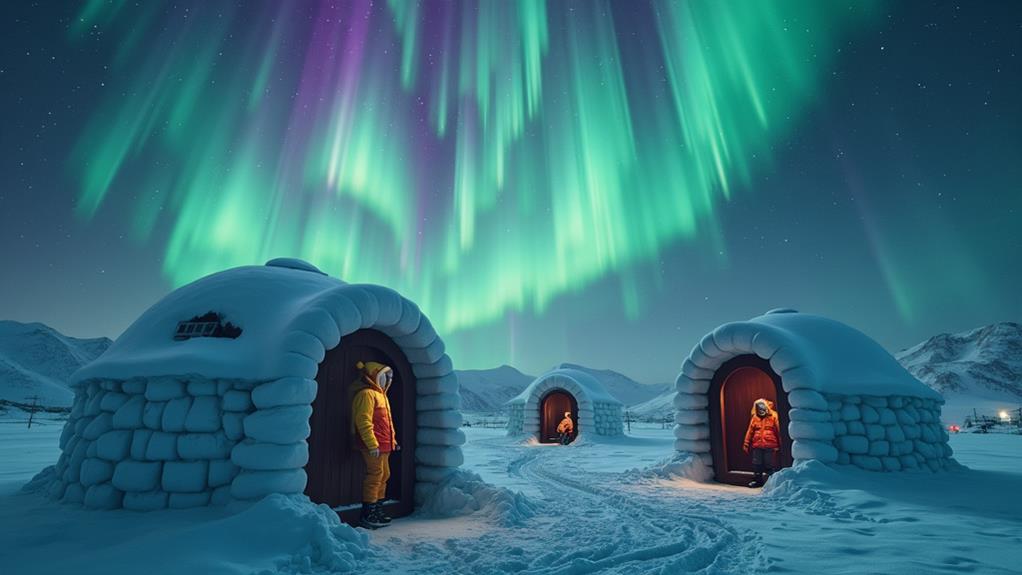
Aurora tourism has surged in popularity, with travelers flocking to destinations like Norway, Iceland, and Finland to witness the mesmerizing Northern Lights. This niche tourism sector attracts over a million visitors annually, offering a variety of packages that enhance the experience. Tour operators often include guided excursions, photography workshops, and cultural experiences that delve into local auroral folklore.
To optimize your chances of seeing the Northern Lights, plan your trip during the winter months, from September to March, when the nights are longest and the skies are clearest in polar regions. Many companies use advanced technology, such as aurora alert apps and real-time forecasts, to increase the likelihood of successful sightings.
Aurora tourism significantly benefits local economies, contributing millions of dollars and creating numerous jobs. Additionally, the increased focus on this natural wonder promotes conservation efforts to protect these pristine landscapes.
Here's what you can expect from a typical aurora tourism package:
- Guided Excursions: Expert-led trips to prime viewing spots.
- Photography Workshops: Instruction on capturing stunning images.
- Cultural Experiences: Exploration of local folklore and traditions.
- Advanced Technology: Utilization of apps and forecasts for better sighting chances.
Environmental Awareness
The Northern Lights do more than captivate the eyes; they deepen our understanding of environmental stewardship. Traditional tales of the auroras underscore the interconnectedness of cultural beliefs and environmental care, reflecting a profound respect for nature among Arctic communities. These stories remind us of the fragile balance within ecosystems that sustain life.
Indigenous narratives often highlight this delicate equilibrium, promoting sustainable practices that honor the land and its resources. The Northern Lights symbolize not only natural beauty but also the importance of conservation efforts to protect the environment from climate change and human impact. These cultural stories serve as powerful warnings against environmental neglect, fostering a sense of responsibility toward preserving the natural world for future generations.
Celebrations and rituals associated with the Northern Lights frequently incorporate themes of gratitude and respect for wildlife. They promote awareness of the delicate relationship between communities and their surroundings, urging us to appreciate and protect this fragile balance. By embracing these traditional tales and cultural beliefs, we can develop a deeper sense of environmental awareness, ultimately contributing to the conservation of our planet's natural beauty.
Modern Interpretations
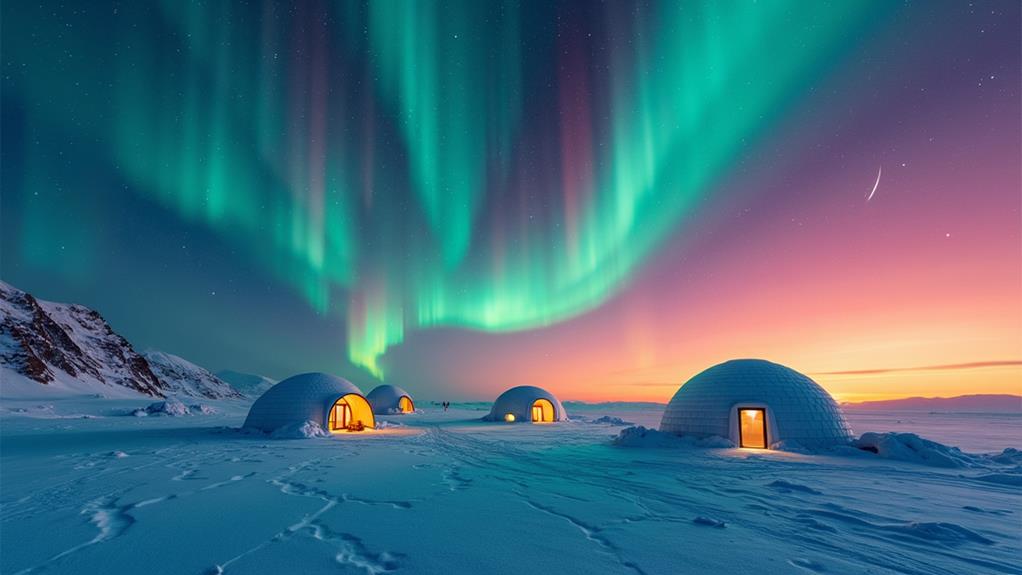
Modern interpretations of the Northern Lights seamlessly integrate science and art, offering a comprehensive appreciation of this natural phenomenon. Scientifically, the Northern Lights are now understood as a result of electrically charged particles from the solar wind interacting with Earth's atmosphere, creating the captivating auroras. This understanding inspires various forms of artistic expression, with contemporary artists incorporating cultural narratives and the ethereal beauty of the lights into their work.
Aurora tourism has surged, particularly in Northern Scandinavia, thanks to technological advancements that improve auroral event predictions. This attracts visitors eager to experience the spectacle firsthand. Social media platforms further amplify interest by showcasing and sharing aurora sightings globally, fostering a community of enthusiasts and raising awareness about this natural wonder.
Educational programs have also emerged, emphasizing the science behind the auroras and their cultural relevance. These initiatives promote environmental awareness and appreciation. Modern interpretations blend distinct elements:
- Scientific Explanations - Understanding the interaction of electrically charged particles with Earth's atmosphere.
- Artistic Expressions - Incorporating cultural narratives and the aesthetic allure of auroras.
- Aurora Tourism - Growing interest in witnessing the Northern Lights in Northern Scandinavia.
- Social Media - Sharing sightings and fostering a global community of enthusiasts.

